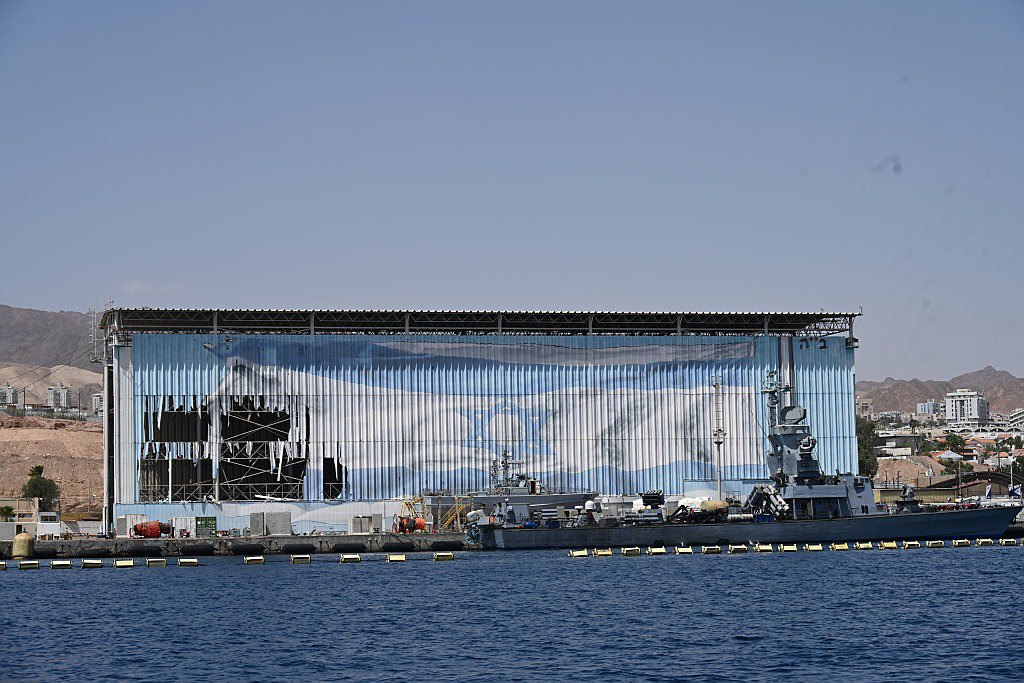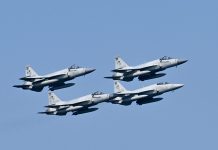It is not only the Houthi militants who have been attacking Israel from the south with drones. There is now a new foe in the east which almost succeeded in destroying one of Israel’s state-of-the-art corvettes at the port of Eilat in the Gulf of Aqaba with a long-range drone.
US Bombers HIT Chinese Embassy: Israel’s Attack On Iranian Consulate Reminds Of Tragic 1999 Incident
In a harrowing incident that underscores the escalating tensions in the region, one of Israel’s Sa’ar 6 class corvettes narrowly evaded a potentially catastrophic strike by a long-range one-way attack drone launched from Iraq.
The corvette was stationed at Eilat in the Gulf of Aqaba when the drone struck a nearby warehouse building on the pier. Video footage captured from a distance provided evidence that the Sa’ar 6 was the intended target.
The imagery taken the morning following the attack displayed observable damage to the pier-side structure, with an older Sa’ar 4.5 ship nearby. The Israeli military also confirmed minor damage at the naval base in the city where the drone struck.
Eilat, known for its energy infrastructure, port, and small naval base, has been recurrently targeted by Houthi drone and missile attacks.
Israeli corvette nearly hit by kamikaze UAV attack.
Kamikaze UAV strike by Islamic Resistance in Iraq almost hit Israeli Navy’s Sa’ar 6-class corvette that appears to be docked adjacent to the area that is hit by an UAV in Eilat, Israel last night. pic.twitter.com/uJeIpyu9Pq
— Clash Report (@clashreport) April 1, 2024
While previous attempts by Houthi militants to target the city with drones and missiles have been thwarted, this latest assault marks an escalation in tactics.
If the drone had struck the Israeli warship, it would have dealt a major blow to the country since these vessels are a crucial part of its defense structure.
The Israeli Navy’s Sa’ar 5 and Sa’ar 6 class ships can be equipped with Iron Dome air defense system launchers while at sea. These launchers protect against aerial threats such as drones and cruise missiles originating from surface vessels in the Red Sea or southern territories.
The Sa’ar 6 class, in particular, is distinct as it is specifically designed to house Iron Dome missiles with fully integrated vertical launch system arrays, setting it apart from the Sa’ar 5 ships.
The Sa’ar 6-class corvette group consists of four corvettes built in Germany for the Israeli Navy. They were commissioned in May 2015. Constructed through a joint venture involving German Naval Yards Holdings and ThyssenKrupp Marine Systems, acting as the main contractor, all four ships were completed in Germany. Three of these vessels attained full operational capability last year.
On October 16, 2023, the Israeli Navy deployed its latest ‘Sa’ar 6’ class missile corvettes, the INS Oz and INS Magen, in a decisive strike against the Hamas infrastructure. This marked the first operational use of these advanced vessels against the militant group.
During the operation, the INS Oz and INS Magen targeted a Hamas weapons manufacturing facility, as well as combat equipment, installations, and observation posts.
Beyond their role in direct combat operations, these navy vessels serve a crucial function in protecting vital national interests. With growing threats from drones and rockets in the region, the Israeli shipping lanes and natural gas platforms in the Mediterranean Sea are vulnerable to potential attacks.
The presence of the Sa’ar 5 and Sa’ar 6 class ships ensures a powerful defense against seaborne terrorism and hostile incursions.
Concerns About Successful Drone Infiltration
The successful infiltration of the drone into the Sa’ar 6 target area has sparked alarm as it could have been launched from Iraq, providing a new and unsettling path of attack.
Israeli military officials have suggested that the weapon originated “from the east.” In the context of Eilat, this direction typically points towards Jordan, in contrast to the usual paths taken by Houthi drones from the south.
Covering a distance of hundreds of kilometers, the drone’s trajectory from Iraq’s southwestern border to Eilat would necessitate passing through Jordan.
Rear Admiral Daniel Hagari of the Israel Defense Forces (IDF) underscored the severity of the strike on Eilat, attributing it to Iranian origins. Hagari also indicated that the IDF was leveraging insights from the incident to bolster air defense measures in the Eilat region.
While the specific model of the drone remains undisclosed, extremist militias, reportedly backed by Iran, possess a formidable arsenal, including ballistic missiles.

Given Iran’s track record of simulated operations targeting Israeli military assets, its involvement in the attack appears plausible, especially considering its expertise in long-range drones.
Robert Tollast, Assistant Foreign Editor at TheNationalNews, highlighted that a video recorded more than two years ago depicts a drone strike targeting a detailed replica of an Israeli Navy facility in Eilat, with the Sa’ar 6 vessel positioned identically as it is in the footage of the recent strike.
Interesting that it hits the warehouse behind the Corvette. https://t.co/n6GNZBOK2u
— Robert Tollast (@roberttollast) April 1, 2024
Meanwhile, following the Eilat drone attack, an unprecedented Israeli airstrike targeted a building adjacent to the Iranian Embassy in Damascus, Syria. The strike resulted in the deaths of several prominent Iranian commanders, further escalating tensions in the region.
Iran’s ambassador to Syria, Hossein Akbari, has confirmed that six missiles, purportedly launched by F-35 jets, struck the consulate in Damascus. Efforts are underway to identify casualties amidst the rubble, even as news about a potential retaliatory response gained traction.
- Contact the author at ashishmichel(at)gmail.com
- Follow EurAsian Times on Google News




